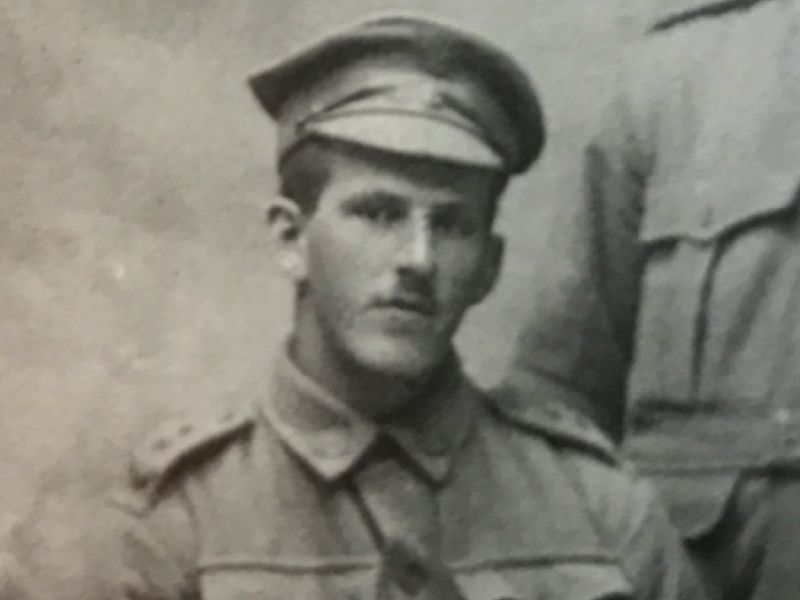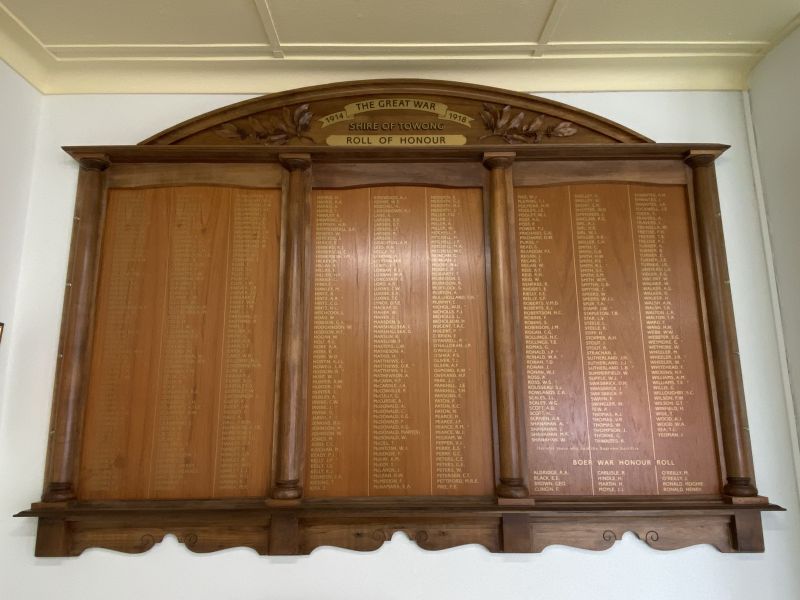Lisle Ben Sutherland
Ben was born in 1895 at Thologolong, Victoria. He was one of twelve children to Peter Alexander and Thomasina (Ina) Mary Eliza (née Carter) Sutherland.
On the 10th of July, 1915, members of the Granya local community attended a recruitment meeting. Prior to the meeting, Jack, Arnold and Ben, the eldest sons of the Sutherland family, drew lots to see who would enlist. Jack and Ben ‘won’, although, as Ben was under the age of twenty-one, he needed his parents to give their consent to enlist. A cousin of Ina’s, Jack Anderson, also enlisted with the two Sutherland boys.
Ben enlisted in late July of 1915, at Melbourne. He was allotted the Regimental Number 3475 and initially placed in the 60th Battalion, 15th Brigade of the 5th Australian Division. His initial training was undertaken at Flemington as part E Company of the 8th Depot Battalion. On the 11th of October, as part of the 11th Reinforcements for the 8th Battalion, he embarked on board HMAT A71 Nestor at Adelaide, South Australia. In February of the following year, Ben was admitted to the 3rd Australian Hospital in Cairo, Egypt, suffering from a bout of influenza. After recovering from his illness he was transferred to the 60th Battalion in late February. However, it wasn’t long before he was back in hospital, this time with the mumps! After recovering from this he was transferred to the 15th Brigade Machine Gun Company, and there he would remain!
On the 17th of June, 1916, he embarked on HT Kalyan at Alexandria bound for France. Six days later the company arrived at the Port of Marseilles in the south of France. At 2200 hours, on the 24th of June, they entrained and left the station at 2305.
Ben was a prolific letter writer, as were those at home. On the 27th of June, 1916, Ben wrote a letter to his parents:
“Just a short note to let you know that I am getting on splendid (somewhere in France). My word, this is great country - talk about scenery, it is something marvellous, to tell you the truth it would make your eyes sore. The scenery on our fifty-eight hour train ride (without a break) was splendid. This place will do me as far as scenery is concerned, as it is not only in one spot but all over. The crop & the grass are just at their prime. They are just starting to cut the crops & cart them in, so I don’t know if you would call it early or late compared with ours. It is very funny the nights being so short over here, why does it not get dark until about ten o’clock at night & daylight again at four in the morning. The first day or two, I used to think it was about five or six o’clock but it was more like eight or nine. I had a bit of sport last night helping to milk the farm herd. I can tell it felt quite strange after not milking for such a long while. The French people think a great lot of the Australians, coming along they used to wave & cheer everywhere we met them. They also give out biscuits & tea & coffee along the line. The next thing to do is to try & look up Jack, but I do not know where his Battalion is, but I heard the other day that they were out of the trenches in a rest camp for a while. Well I will have to bring this note to a close, as news is pretty scarce. Please give my love to all.”
Soldiers of the newly arrived 5th Australian Division, together with the British 61st Division, were tasked with attacking the strongly fortified German front line positions near Aubers Ridge in the north of France. Along that ridge was the small French village of Fromelles. The battle would be the first one experienced by Australian soldiers on the Western Front. The attack itself was intended to be a feint, to draw German reserves and hence take the pressure off the Allied offensive along the Somme. It turned out to be the worst day in Australian military history. It would become a model of how not to plan and carry out an attack on heavily fortified positions. Australian and British soldiers assaulted over open ground in broad daylight, and under direct observation and heavy fire from the German lines. In 24 hours the Australian 5th Division would have over 5,500 casualties, with almost 2,000 of them being killed or died of wounds. Over 400 would be captured. One of those casualties was Private Ben Sutherland.
It was customary for the OC (Officer Commanding), a platoon or company, to write to the parents of those men they had lost. Three days after Ben's death, his company commander, Captain S.W. Neale wrote to Peter and Ina.
“Thinking that you will derive a little relief by the information, I am writing to give you the details of the death of your son, Ben, who died on the 19th July.
He was with his section in the front line, sitting close up against the parapet waiting until the time came to advance. There was a terrific bombardment on, and one shell landed in the trench. It was the only shell to land in that part of the trench all day. Death was instantaneous and your son was buried next day with the Presbyterian chaplain present.
For eight days before the attack, his section was in the support line and I had many a chat with him while I was going around the positions. He was always cheerful & always answered with a smile. His loss to me is a great one; the loss to the company still greater.
I am sending you [a] few of his photos. His two pocket books will be sent to you later by the authorities at the base.
If there is any information that I can give you, Mr Sutherland, kindly write to me - his friend and company commander.”
The effect of Ben’s death was devastating, not only to the direct family, but on other people who knew him. Elsie Collins was Ben's sweetheart. She refused to become engaged to him before he left for overseas. She wanted to wait until he came home. Ben didn’t come home and Elsie never married.
The 19th of August 1916 edition of The Border Mail and Riverina Times ran an article about Ben’s death.
“KILLED IN ACTION
PRIVATE BEN SUTHERLAND
As already announced in these columns, Private Ben Sutherland, son of Peter Sutherland, of Thologolong Station, and President of the Towong Shire Council, was killed in action on July 19.
“Ben, who was not long out of his teens, was physically a fine specimen of young Australian manhood, and he was a fine character personally - a lovable lad. His death is much regretted in Tallangatta, where he went to school. The Victorian Secretary of Education authorised the closing of the Tallangatta School for one day, as a tribute to the memory of Private Ben Sutherland. The head teacher (Mr. B.T. Pearse), in addressing the children, said that it seemed only yesterday that Ben was in the school ranks, and now he, a brave, clean soldier, had fallen fighting for the homes of the very children who attended school with him. As Ben had come nightly to school to study, he (the head teacher) had spent hundreds of hours in his company. He had been honored in being admitted to close friendship with such a straight, noble fellow - a friendship which even death could not sever. He thanked the Department for closing the school, and would telegraph the sympathy of them all to Mr. and Mrs. Sutherland. Before leaving for the front, Ben had posted to his old friends a photo of himself in khaki. This would be enlarged and hung on the wall in front of Ben’s old desk, and a duplicate would be presented by the children to the hero’s sorrowing family. Subscriptions would be received from school-mates and friends of Mr. and Mrs. Sutherland. The school flag was flown at half mast.”
Ben was buried at the Ruis-du-Bois Military Cemetery at Fleurbaix, France. He is also remembered on the Australian War Memorial Roll of Honour, and the Towong Shire Boer War and WW1 Memorial in the Memorial Hall in Tallangatta. For his service during the First World War, he was awarded the 1914-1915 Star, the British War Medal and the Victory Medal.

 Stephen Learmonth
Stephen Learmonth